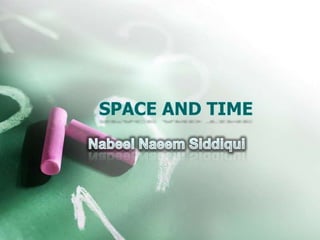
Space and Time
- 2. Spatial Messages:- •Edward T. Hall •The cultural anthropologist who coined the term in 1963, emphasized the use of space on interpersonal communication.
- 3. INTIMATE DISTANCE The close phase is used for wrestling, comforting and protecting. • embracing, touching or whispering • Close phase – less than 6 inches (15 cm) • Far phase – 6 to 18 inches (15 to 46 cm)
- 4. PERSONAL DISTANCE It allows you to stay protected and untouched by others. • Interactions among good friends or family members • Snakes will attack you if you are around their nest of eggs. • Close phase – 1.5 to 2.5 feet (46 to 76 cm) • Far phase – 2.5 to 4 feet (76 to 120 cm)
- 5. SOCIAL DISTANCE It is the distance at which you conduct impersonal business or social gathering. • This distance is maintained with people you don’t know or don’t know well. • Close phase – 4 to 7 feet (1.2 to 2.1 m) • Far phase – 7 to 12 feet (2.1 to 3.7 m)
- 6. PUBLIC DISTANCE In the close phase, a person seems protected by space. •When talking to an audience or large group of people, you feel less anxiety at this distance. •used for public speaking • Close phase – 12 to 25 feet (3.7 to 7.6 m) • Far phase – 25 feet (7.6 m) or more.
- 7. Diagram of Edward T. Hall
- 8. PROTECTION THEORY It holds that you established a body buffer zone around yourself as protection against unwanted touching or attack.
- 9. EQILIBRIUM THEORY This theory says that you maintain close distances with those with whom you have close interpersonal relationships and that you maintain greater distances with those with whom you do not have close relationships. This theory states that you don’t maintain greater distance with those whom you’re close to and maintain a greater distance with those who are close to you.
- 10. EXPECTANCY VIOLATIONS THEORY Which explains what happens when you increase or decrease the distance between yourself and another in an interpersonal interaction. This defines the boundaries that you maintain while communicating with others. These vary from culture to culture. In western cultures the boundaries are limited and in eastern cultures there are more boundaries.
- 11. TERRITORIALITY Territoriality is of three types. • Primary: areas that you own. For example your own room.
- 12. TERRITORIALITY • Secondary: areas that you don’t own but are yours, for example a shopkeeper’s shop on rent, house on rents.
- 13. TERRITORIALITY • Public: Areas that are open to all, for example hospitals, parks
- 14. TERRITORIALITY • OWNERSHIP This theory can be explained with the example of animals. A lion will allow other lions to enter his area but wouldn’t allow other animals to enter. • STATUS This defines territories by status. For example Dean of a university can enter the rooms of faculty members when he wants but the staff and students aren’t allowed to enter his office without taking prior permission.
- 15. ARTIFACTUAL COMMUNICATION • SPACE DECORATION This refers to the interior and decoration of a place that exhibits what the place is for. For example after entering a university one can tell by its décor that its made for education purpose.
- 16. ARTIFACTUAL COMMUNICATION • COLOUR COMMUNICATION This refers to the way colors communicate the feelings of people. For example red color in west means love and yellow means friendship.
- 17. ARTIFACTUAL COMMUNICATION • CLOTHING AND ADORNMENT Different cultures have different dress codes. They define the country from where those people belong. For example in Pakistan the national dress is shalwar kameez, and in India women wear sarees.
- 18. ARTIFACTUAL COMMUNICATION • SCENT Smell is a peculiar aspect of nonverbal communication and is discussed in widely different ways by different writers. Body odor also communicates. You also use odors to make yourself feel better. When the smells are pleasent, you feel better about yourself, whe the smells are unpleasent you feel less good about yourself. • GIFTS AND CULTURE Giving of gifts, a practice in which rules and customs vary according to each culture.
- 19. TEMPORAL COMMUNICATION CULTURAL TIME: It has three types. • TECHNICAL TIME Technical time is precise,scientific time. Milliseconds and atomic years are examples of units of technical or scientific time. • FORMAL TIME It refers to the manner in which a culture defines time. In united states time is divided into seconds ,minutes ,hours, days ,weeks,months and year. • INFORMAL TIME It refers to a rather loose use of time terms-for e.g words such as “forever”, ”immediately”, ”soon”, “right away”, and “as soon as possible”.
- 20. TEMPORAL COMMUNICATION • DISPLACED AND DIFFUSED TIME ORIENTATIONS In a displaced time orientation, time is viewed exactly. Persons with this orientation will be exactly on time. In a diffused time orientation , time is seen as approximate rather than exact. People with this orientation are usually late for appointments because they understand, for e.g a scheduled time of 8:00 as meaning anywhere from 7:45 to 8:15 or 8:30. Even the accuracy of clocks varies in different cultures and probably reflects each culture’s time orientation. Clocks in japan were found to be the most accurate, while clocks in Indonesia were least accurate.
- 21. TEMPORAL COMMUNICATION • MONOCHRONIC People or cultures (the united states, germany,switzerland etc are good examples) schedule one thing at a time. • POLYCHRONIC People or cultures (latin america, arabs etc are good examples) schedule a number of things at the same time. Eating, conducting business with several different people and taking care of family matters may all be conducted at the same time.
- 22. TEMPORAL COMMUNICATION PSYCHOLOGICAL TIME It is the personal orientation of a person to time and is generally divided into three orientations: past, present, and future.
